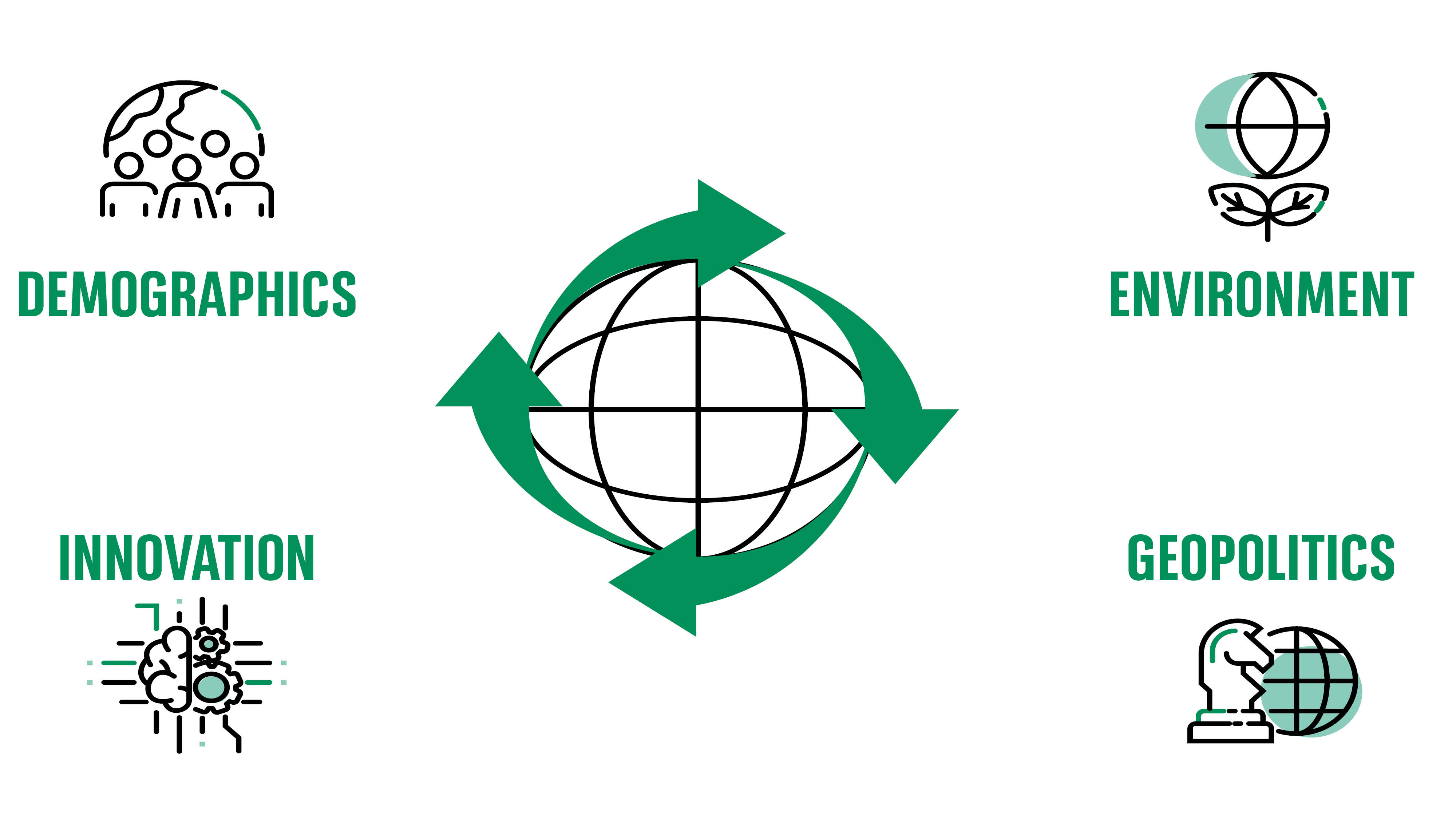
Sustainable investing in 2026: The continuing path to a more resilient future
KEY POINTS
Recent years have seen investors operate in an environment shaped by conflicts, inflationary pressures, extreme weather events, and growing digital disruption. These events, coupled with the longer-term sustainability themes shaping our decade – climate change, biodiversity loss, and rising inequality – are redefining risks in capital markets and placing long-term investment resilience under scrutiny.
Meanwhile, sustainability-related regulations are evolving, such as the EU Omnibus Directive – which seeks to streamline the Corporate Sustainability Reporting Directive (CSRD) – the Corporate Sustainability Due Diligence Directive (CSDDD), and the Sustainable Finance Disclosure Regulation (SFDR).
Simplifications are broadly a response to regulatory fatigue and offer the opportunity for streamlining, which we support provided ambition is maintained. In the US, there is significant push back against what is perceived as a ‘woke’ sustainability agenda. But this is not the case worldwide.
| “Understanding the trends shaping 2026 is critical for managing risk and identifying opportunities” |
New opportunities
Amid this shifting landscape, our duty as an asset manager is to make well-informed investment decisions, carefully considering sustainability risks and opportunities. Understanding the trends shaping 2026 is critical – not only for managing risk, but also for identifying new areas of growth and opportunity, in terms of capital allocation and aligning stewardship activity with the aim of addressing systemic risks in portfolios and markets.
In 2026, investors will look to address the societal and sustainability challenges shaping markets and economies in an interconnected manner. Our global thematic framework supports this, helping to identify related risks and opportunities – and there are significant elements to consider, as highlighted below.

Source: BNP Paribas Asset Management, October 2025
Demographics
Demographic shifts, inequality, pressure on human capital, human rights and public health are driving demand for more inclusive and resilient systems. While complex, such issues can lead to innovative solutions and new investment opportunities.
Innovation
Technological advancement also brings risks and opportunities. While responsible development of artificial intelligence (AI) and stronger cyber resilience are important, AI can be a powerful enabler of sustainability-related solutions, offering scalable tools to tackle environmental challenges. It can also help investors and companies embed environmental, social and governance (ESG) insights into their decision making, enhance transparency and identify long-term sustainable value.
The environment and geopolitics
As the physical impacts of climate change become more apparent, the urgency to act will increase. While the transition to a low carbon economy faces some political and regulatory headwinds, the technological and societal shifts underlying the transition will persist and continue to demand investors’ attention. The Asia-Pacific region is a leader in driving the global energy transition, creating potentially significant investment opportunities.
Within a shifting geopolitical landscape, strong corporate governance and business ethics, as well as progress in integrating sustainability in emerging markets could unlock sustainable growth.
Investors, notably institutional clients, staying the course
It has been a turbulent period for ESG portfolios, which endured net outflows early in 2025. However, the second quarter (Q2) enjoyed a strong rebound, with $4.9bn in net inflows globally, driven by European investors who added $8.6bn after redeeming $7.3bn the previous quarter. Despite some outflows in Q3, total sustainable fund assets climbed to $3.7trn, an increase of around 4%, supported by stock market appreciation1.
European investors remain firmly committed to sustainability, and climate remains their top priority. Institutional investors – pension funds, insurers, sovereign wealth funds – are not only maintaining climate commitments but scaling them. One recent survey shows 58% of UK and European asset managers plan to increase impact allocations in the next year, with none intending to reduce them2.
In Asia Pacific, we have seen continued progress on several sustainability priorities – for example, the region is set for a record year for sustainable debt issuance in 2025. In addition, 80% of asset owners in the region expect assets under management in sustainable funds to grow over the next two years3.
For us three climate-related investment strategies stood out in 2025, which we expect to remain in focus in 2026.
| “Along with climate and nature solutions, green bonds and decarbonisation will remain in focus in 2026” |
1. Green bonds
Green bonds finance projects like renewable energy, green buildings, and low carbon transport, offering similar risk profiles to conventional bonds but with added transparency and impact reporting. The market has grown from €30bn a decade ago to €1.9trn today. It has grown into a global universe, with breadth and depth in terms of sectors and issuers. Although 2025 issuance may be slightly lower than 2024’s record of some €420bn, innovation continues, notably with European green bonds gaining traction. The broader green, social, and sustainability (GSS) bond market now rivals the euro investment-grade credit sector at €3trn, with green bonds as its cornerstone4. The state of the market should come as little surprise given that today, green bonds are entrenched in the mainstream – and have been for some time – typically offering a comparable yield to conventional bonds.
2. Decarbonisation
Asset owners are moving from pledges to action, adopting frameworks like the Net Zero Investment Framework and the Task Force on Climate-related Financial Disclosures (TCFD). Decarbonisation strategies focus on seeking opportunities associated with the transition to a low-carbon economy and reducing exposure to carbon emissions and are gaining traction across equities and fixed income. Climate and Paris-Aligned Benchmark exchange-traded funds are also seeing increased interest.
3. Climate and nature solutions
Investors are allocating capital to solutions that address climate and biodiversity challenges. These include clean energy, sustainable agriculture, resilient infrastructure and water management. The goal is to invest in financially sound and scalable companies delivering measurable environmental outcomes – such as carbon emissions avoided – or restoring ecosystems. Climate change and biodiversity loss are a systemic issue and addressing them demands solutions that match their considerable scale. These environmental strategies not only help manage physical climate risks but also open new investment opportunities in underserved markets.
- Source: Morningstar Global Sustainable Fund Flows: Q2 2025 in Review / Global Sustainable Fund Flows: Q3 2025 in Review | Morningstar
- Pensions for Purpose / Nearly all (93%) of UK and European institutional investors "concerned" about sustainability under a Trump presidency – press release | Pensions For Purpose
- Morgan Stanley, July 2025
- All Green Bond / GSS data source: Bloomberg as of 6 October 2025
Looking ahead
Despite policy shifts in the US, Europe continues to lead in sustainable investing, offering a strong pipeline of opportunities with attractive risk-return profiles – and European governments, corporates, and investors are staying the course. For European investors, sustainability is not a trend—it’s a strategic imperative. And with Asia’s growing role in driving the energy transition, we have two clear regions driving this focus.
Disclaimer
This document is for informational purposes only and does not constitute investment research or financial analysis relating to transactions in financial instruments as per MIF Directive (2014/65/EU), nor does it constitute on the part of AXA Investment Managers or its affiliated companies an offer to buy or sell any investments, products or services, and should not be considered as solicitation or investment, legal or tax advice, a recommendation for an investment strategy or a personalized recommendation to buy or sell securities.
Due to its simplification, this document is partial and opinions, estimates and forecasts herein are subjective and subject to change without notice. There is no guarantee forecasts made will come to pass. Data, figures, declarations, analysis, predictions and other information in this document is provided based on our state of knowledge at the time of creation of this document. Whilst every care is taken, no representation or warranty (including liability towards third parties), express or implied, is made as to the accuracy, reliability or completeness of the information contained herein. Reliance upon information in this material is at the sole discretion of the recipient. This material does not contain sufficient information to support an investment decision.
Disclaimer
This website is published by AXA Investment Managers Asia Limited (“AXA IM HK”), an entity licensed by the Securities and Futures Commission of Hong Kong (“SFC”), for general circulation and informational purposes only. It does not constitute investment research or financial analysis relating to transactions in financial instruments, nor does it constitute on the part of AXA Investment Managers or its affiliated companies an offer to buy, sell or enter into any transactions in respect of any investments, products or services, and should not be considered as solicitation or investment, legal, tax or any other advice, a recommendation for an investment strategy or a personalised recommendation to buy or sell securities under any applicable law or regulation. It has been prepared without taking into account the specific personal circumstances, investment objectives, financial situation, investment knowledge or particular needs of any particular person and may be subject to change at any time without notice. Offering may be made only on the basis of the information disclosed in the relevant offering documents. Please consult independent financial or other professional advisers if you are unsure about any information contained herein.
Due to its simplification, this publication is partial and opinions, estimates and forecasts herein are subjective and subject to change without notice. There is no guarantee such opinions, estimates and forecasts made will come to pass. Actual results of operations and achievements may differ materially. Data, figures, declarations, analysis, predictions and other information in this publication is provided based on our state of knowledge at the time of creation of this publication. Information herein may be obtained from sources believed to be reliable. AXA IM HK has reasonable belief that such information is accurate, complete and up-to-date. To the maximum extent permitted by law, AXA IM HK, its affiliates, directors, officers or employees take no responsibility for the data provided by third party, including the accuracy of such data. This material does not contain sufficient information to support an investment decision. References to companies (if any) are for illustrative purposes only and should not be viewed as investment recommendations or solicitations.
All investment involves risk, including the loss of capital. The value of investments and the income from them can fluctuate and that past performance is no guarantee of future returns, investors may not get back the amount originally invested. Investors should not make any investment decision based on this material alone.
Some of the services listed on this Website may not be available for offer to retail investors.
This Website has not been reviewed by the SFC. © 2025 AXA Investment Managers. All rights reserved.





